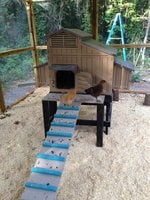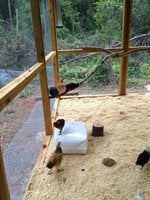Hobbshouse14
Chirping
- Jun 3, 2016
- 60
- 22
- 77
Follow along with the video below to see how to install our site as a web app on your home screen.
Note: This feature may not be available in some browsers.
You're looking at the wrong ends of your chickens for recent injuries that would account for the blood splatters. Look at the combs, not the vents.
Are you where it's early summer? Hormones and tempers can get pretty heated up, hens, and even the rooster, will all try to crowd into a single nest at once. It can be a real circus.
After one such episode, which I happened to snap a photo of, blood splatters decorated the inside walls of the nest box after the wild party broke up.View attachment 1221579



We have a 12x32’ covered run that is accessible from sun up until they go in to roost at night and a coop with three roosting bars (they usually leave the bottom one unoccupied) and four nesting boxes for nine girls and one boy. We also have many roosting spaces in the run with lots of space to let them get away from each other. How do I keep a new layer from being bullied in the nesting box? I’ve never seen our rooster go in the coop during the day. He likes to stay out in the big covered run as do all the girls unless they are laying.If it has been cold and they are confined to the coop, sometimes they get ratty and fights break out. I would agree that combs are the most likely injured area to look for. Birds just coming into lay sometimes try to improve their pecking order status and that can lead to fights too.
If the blood is in all 4 nesting boxes it sounds like one of them has been unsuccessfully trying to find sanctuary, perhaps from a bully. How big is your coop and how many chickens in it? The blue bird in the second photo looks like she may have comb damage?
You have a fantastic eye from a blurry shot. I went back out to look and sure enough, Lola has a bloodied comb. It looks clotted. I can see one other girl with a bloodied comb as well, also clotted and not as obvious as Lola’s.If it has been cold and they are confined to the coop, sometimes they get ratty and fights break out. I would agree that combs are the most likely injured area to look for. Birds just coming into lay sometimes try to improve their pecking order status and that can lead to fights too.
If the blood is in all 4 nesting boxes it sounds like one of them has been unsuccessfully trying to find sanctuary, perhaps from a bully. How big is your coop and how many chickens in it? The blue bird in the second photo looks like she may have comb damage?